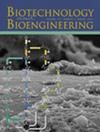Isolation of Anammoxosomes From the Aggregate Culture of Ca. Brocadia Sapporoensis and Assembly of Ladderane Liposomes
IF 3.5
2区 生物学
Q2 BIOTECHNOLOGY & APPLIED MICROBIOLOGY
引用次数: 0
Abstract
Anammox bacteria wield an energy‐efficient nitrogen metabolism enveloped in anammoxosome organelle composed of unique ladderane lipids. Thus, waste anammox biomass seems to be an attractive target for the isolation of ladderanes and subsequent production of artificial vesicles for drug delivery. This study proposed a novel method to isolate ladderane‐rich anammoxosomes from aggregate mixed culture of札幌花楸聚集培养厌氨粘液体的分离及脂质体的组装
厌氧氨氧化菌具有能量高效的氮代谢,它被包裹在由独特的阶梯烷脂组成的厌氧氨酶细胞器中。因此,厌氧氨氧化废物生物质似乎是一个有吸引力的目标,用于分离阶梯烷和随后生产用于药物输送的人工囊泡。本研究提出了一种新的方法,从混合培养的日本札幌Ca. Brocadia sapporoensis聚集体中分离出富含ladderane的厌氨粘液体。与传统的分离方案相比,该方案简化了厌氧氨氧化细胞的预纯化,用蔗糖梯度代替Percoll®,延长了EDTA的应用时间。这种增强和简化的程序有效地去除了EPS和其他碎片,从而产生了对照实验和透射电镜证实的无粘胶体层。本研究首次将所得的脂质体分离物用于制备含和不含纯双棕榈酰磷脂酰胆碱(DPPC)的脂质体。通过TEM和DLS对囊泡进行了表征,并将厌氧氨氧化基阶梯烷掺入囊泡壁中。这些脂质体具有有趣的功能特性,例如在高浓度下增加胶体稳定性,这意味着与仅由DPPC制成的模型脂质体相比,形成聚集体的倾向降低。总的来说,这项研究为将厌氧氨氧化废物转化为药物输送的宝贵资源提供了见解。
本文章由计算机程序翻译,如有差异,请以英文原文为准。
求助全文
约1分钟内获得全文
求助全文
来源期刊

Biotechnology and Bioengineering
工程技术-生物工程与应用微生物
CiteScore
7.90
自引率
5.30%
发文量
280
审稿时长
2.1 months
期刊介绍:
Biotechnology & Bioengineering publishes Perspectives, Articles, Reviews, Mini-Reviews, and Communications to the Editor that embrace all aspects of biotechnology. These include:
-Enzyme systems and their applications, including enzyme reactors, purification, and applied aspects of protein engineering
-Animal-cell biotechnology, including media development
-Applied aspects of cellular physiology, metabolism, and energetics
-Biocatalysis and applied enzymology, including enzyme reactors, protein engineering, and nanobiotechnology
-Biothermodynamics
-Biofuels, including biomass and renewable resource engineering
-Biomaterials, including delivery systems and materials for tissue engineering
-Bioprocess engineering, including kinetics and modeling of biological systems, transport phenomena in bioreactors, bioreactor design, monitoring, and control
-Biosensors and instrumentation
-Computational and systems biology, including bioinformatics and genomic/proteomic studies
-Environmental biotechnology, including biofilms, algal systems, and bioremediation
-Metabolic and cellular engineering
-Plant-cell biotechnology
-Spectroscopic and other analytical techniques for biotechnological applications
-Synthetic biology
-Tissue engineering, stem-cell bioengineering, regenerative medicine, gene therapy and delivery systems
The editors will consider papers for publication based on novelty, their immediate or future impact on biotechnological processes, and their contribution to the advancement of biochemical engineering science. Submission of papers dealing with routine aspects of bioprocessing, description of established equipment, and routine applications of established methodologies (e.g., control strategies, modeling, experimental methods) is discouraged. Theoretical papers will be judged based on the novelty of the approach and their potential impact, or on their novel capability to predict and elucidate experimental observations.
 求助内容:
求助内容: 应助结果提醒方式:
应助结果提醒方式:


